Sometimes, your pepper plants end up top-heavy. Early pruning can help avoid tall, lanky pepper plants. However, as they grow larger, staking pepper plants is a great option to help avoid damage from wind and rain.
Depending on the variety, pepper plants can grow anywhere from 2 to 8 or more feet tall in a single season. The important factor is where the plant’s weight is distributed.
If most of the branches, leaves, and fruits form at the top of the plant, it can have a tendency to lean. This is where staking can be highly beneficial to the health and aesthetics of your garden.
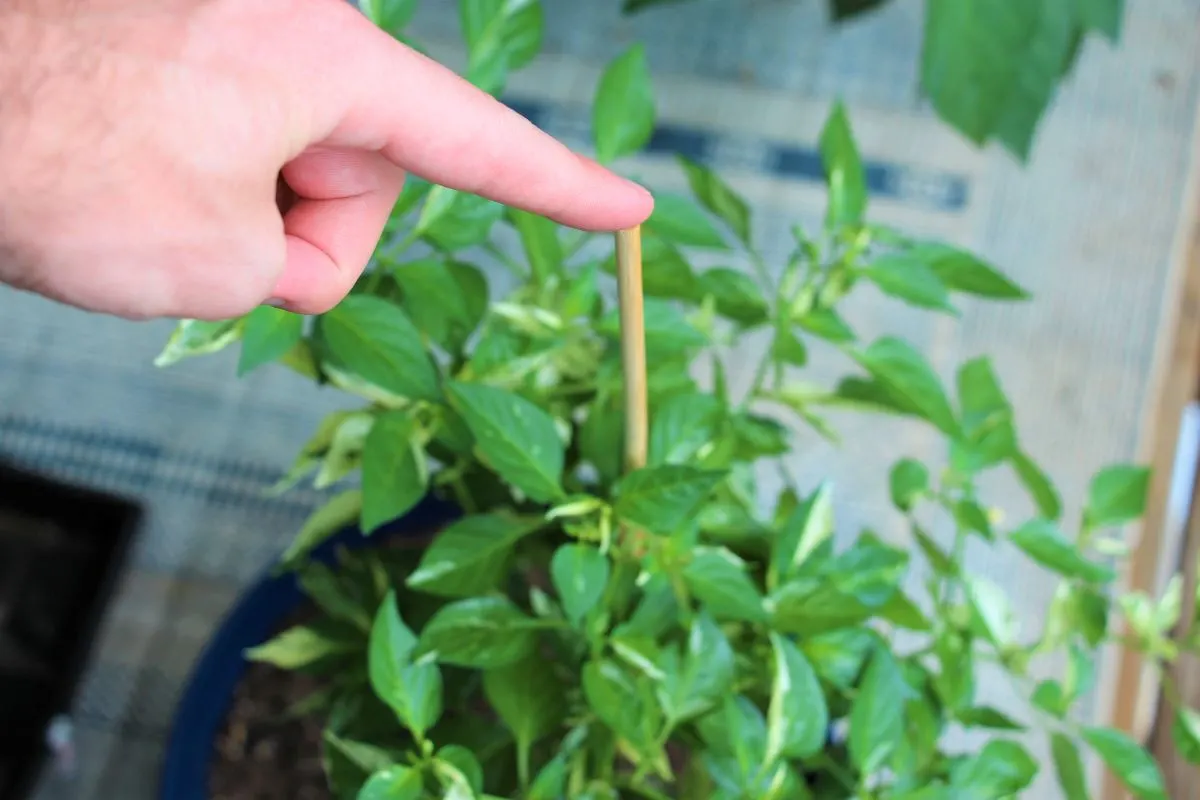
By providing sturdy support, your pepper plants will stay upright, allowing for better airflow and easier harvesting. Staking your peppers will also keep the plants from falling over or breaking in windy conditions.
In this article, we’ll share our best tips for staking pepper plants the right way.
What Is Staking?
Staking involves providing your plant with the support of an upright object, usually a sturdy piece of wood, metal, or plastic. We suggest placing a stake beside each pepper plant early in the season to ensure the plants are supported from day one.
However, peppers are not always in need of support – it depends on the variety being grown. For example, many C. annuum varieties grow shorter and bushier, often having all the support they need from their own main stem.
Bell peppers are an exception, as the weight of the fruits themselves can cause bending and breaking of stems. Any heavy pepper variety should have a support system to prevent this.
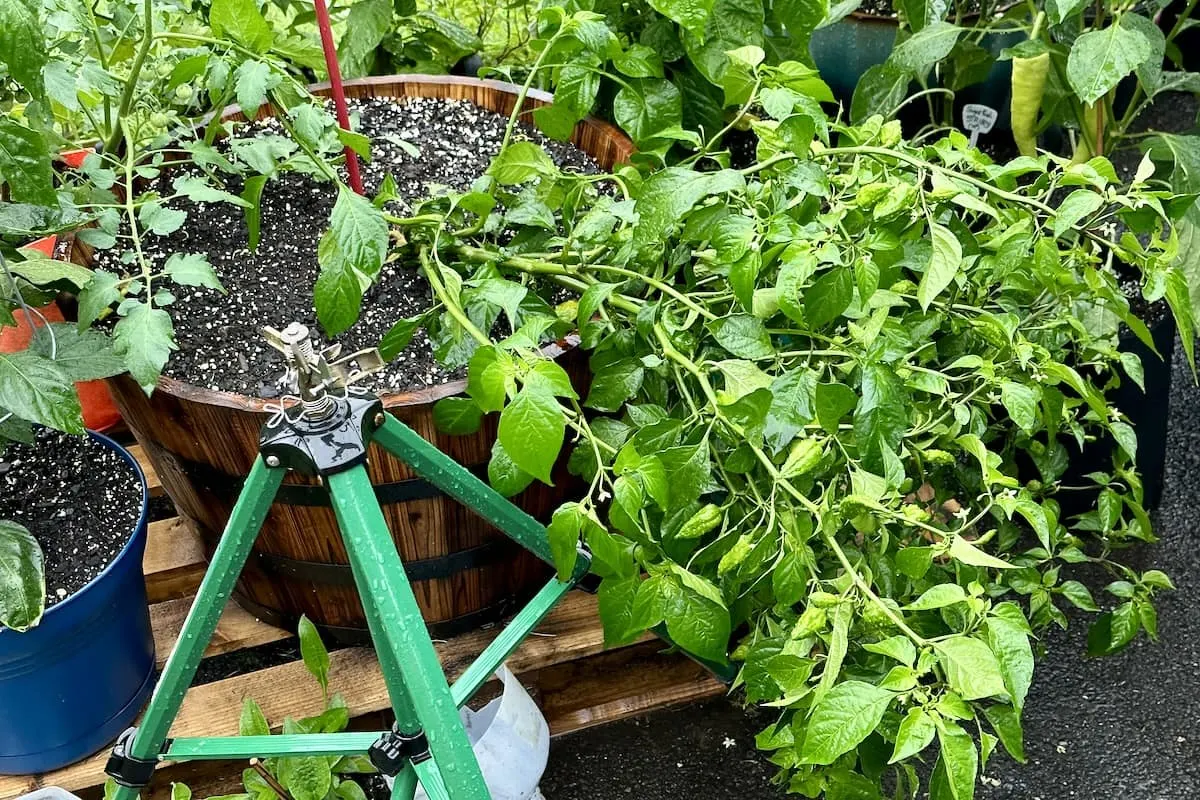
C. chinense peppers, like ghosts and habaneros, grow to be much larger and bushier, often becoming top-heavy with fruits. These plants benefit from a sturdy stake or cage that can be tethered to the plant.
What To Use For Staking Peppers
We have seen some very creative methods of staking plants. From a simple wooden stake to a complex trellis for climbing plant varieties.
For peppers, the stake doesn’t have to be anything fancy. It should be sturdy enough to support your peppers in windy conditions, but it doesn’t need to be overly thick. Here are some items we recommend using to stake your peppers.
Skewers (for Young Plants)
When peppers are young and being hardened off, they can be staked with a lightweight, sturdy skewer. These are great because they are sharp, helping to avoid any damage to the young roots. These are not strong enough to support a full-grown plant.
We like these long, wooden skewers with pointed ends.
Note: One benefit of these are their thin nature. They are typically no more than a half centimeter wide, and pointed at the end. Great for seamlessly sliding through the soil without disturbing the roots.
Traditional Stakes
Traditional stakes usually consist of a straight, pointed piece of wood, bamboo, metal, or other rigid material. They are purpose-built, and are easy to find at local garden centers.
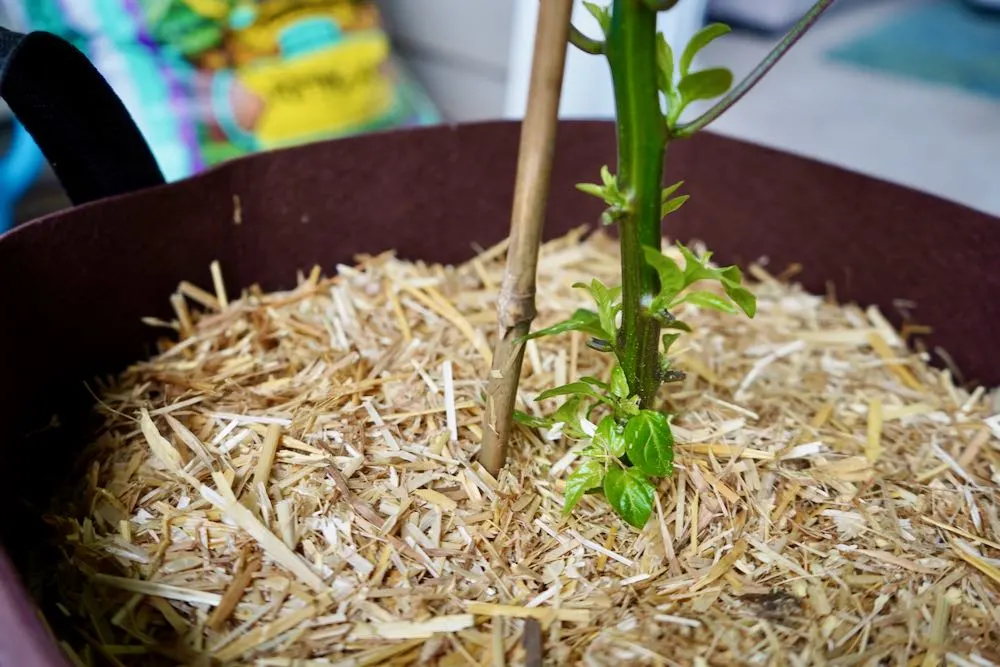
These types of stakes should be driven into the ground 2-3″ from the base of your pepper plants. Then, as the plants grow, you can attach them at various points of the plant to the stake for support. We love using Garden Velcro tape to attach our peppers to stakes.
You can also get a variety of stake options online on Amazon or Home Depot. They are economical, reusable, and made specifically for this purpose. Get something that suits your garden!
Note: Thick, wooden stakes may disrupt your plant’s root system. When using these, place them in the soil just before transplanting to avoid issues.
Metal Stakes
If you need an extra-sturdy stake for your larger pepper plants, you can buy plastic-coated metal stakes. These come in a variety of sizes and thicknesses, from 2′ to 8′ depending on your needs. I’d recommend going with 3-4′ stakes for most pepper varieties.
Fallen Tree Branches
If you want a rustic garden look, or don’t wish to spend money on stakes, find some straight, recently fallen tree branches. Just make sure they still have some strength, and that they will not snap halfway through the season.
Though these may not be reusable for many years, you should have no trouble finding fresh branches each season.
Tip: Sharpen the end of the tree branches before staking. This will allow the branch to slide between the root system more easily.
How To Stake Peppers
The process of staking is simple, but there are a few important steps to take. You want to avoid disturbing your pepper plant’s root system in the process.
Cost: $5-10 USD (Free if you’re crafty)
Materials:
- Stakes – Home Depot or Amazon
- Staking Velcro or ties – Home Depot or Amazon
Steps For Staking Peppers:
- Determine Which Way Your Plant Leans.
If your pepper plant is leaning to the right, you will want to insert your stake on the left side of the plant’s base. The stake will do a better job pulling the plant up than pushing it. If your plants are not yet leaning, you can skip this step.
- Insert Stake 2-3″ From Base Of Plant.
After determining where to place it, in one fluid motion, insert your stake at the base of your pepper plant, about 2-3 inches from the base of the stem. Push it down at least 6 inches until the stake is sturdy. If you are growing peppers in pots, push the stake to the bottom of the container (as long as your stakes are long enough).
Tip: Ideally, you should place your stake before the plants are in the ground. This way, you can avoid potentially damaging the root systems by driving a stake through them. - Tether Plant To Stake.
Using Velcro, zip ties, twist ties, or string, loosely tether the plant to the stake. If your plant is leaning, gently pull it toward the stake and fasten the main stem to the stake, about halfway up the plant. Leave some room to allow for growth.
Tip: Secure the plant just above a node on the main stem to ensure the tie won’t move as the plant continues to grow.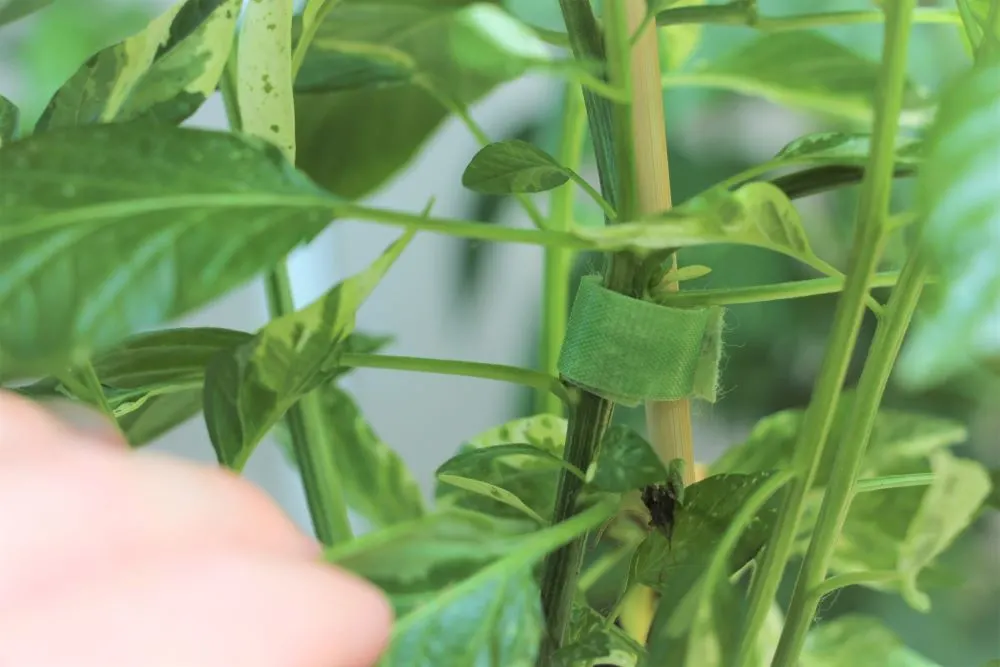
After you have successfully staked your pepper plants, you should check on them after a day or two to ensure the tie is holding. Also, give the stake a little movement test to ensure it is sturdy.
Tip: If your stakes are tall enough, you can dual-purpose them into garden pest deterrents. Just tie some tin pie pans (or something else lightweight and shiny) from the top – they will blow around in the wind, making noise and reflecting light.
Another important tip is to put something on top of your stakes to avoid the danger of eye damage. When you bend over to tend to your plants, there is a chance you might accidentally catch yourself on the tip of your stakes. Some gardeners use empty aluminum soda cans as a free option.
As your pepper plants grow, they should be regularly tethered to the stake to provide additional support. If your plants grow additional stems, adding more support around each plant may help support the weight of the fruits.
Can I Use a Tomato Cage for Staking Peppers?
Tomato cages can be used to support peppers. In fact, I think tomato cages are more useful for pepper plants (especially bushy varieties or types with heavy fruits) than they are for some tomatoes.
The circular supports that surround these types of cages are perfect for hanging branches and heavy fruits, like bell peppers or other large types. They are also great for any C. chinense variety plants, as they tend to branch heavily.
The height of tomato cages is usually perfect, too, at around 4′ in height above the surface of the soil. They are re-usable and can make for a nice, uniform appearance in the pepper garden.
Do Pepper Plants Need Cages?
Smaller pepper varieties will be just fine without a cage. A simple, central stake is plenty of support for most pepper varieties, using some Garden Velcro or string to attach the plants at various points as they grow.
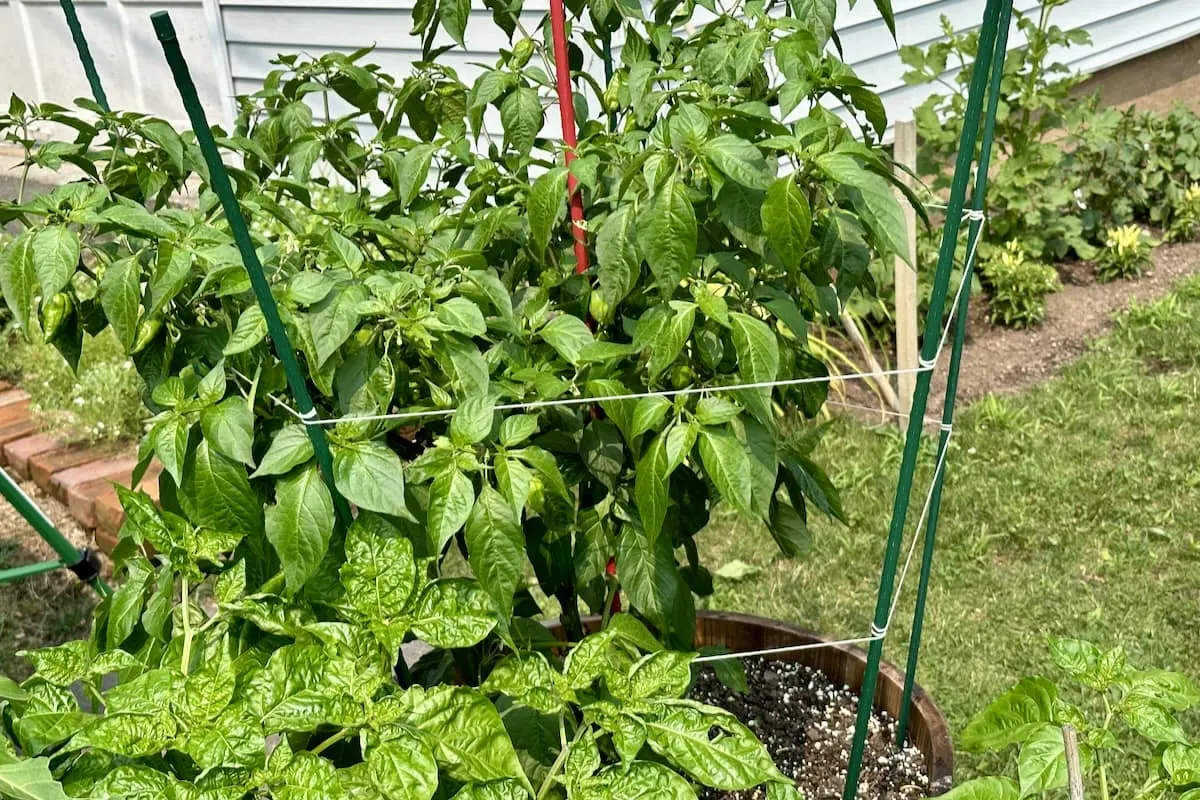
Pepper types that may benefit from a cage:
- Bell peppers (for supporting heavy fruits)
- Habanero peppers
- Ghost peppers
- Most Capsicum chinense type peppers
- Jalapeños
- Banana peppers
Pepper varieties that likely don’t need a cage:
- Small red chilies (such as Thai, tabasco, cayenne, etc.)
- Shishito peppers
- Most smaller fruit sized peppers
Tip: By planting peppers closer to one another (~12-18″), they will support each other, often requiring little or no staking. However, it may become more difficult to access the plants for harvesting and watering.
Another factor to consider is how long your plants will be alive. In colder climates, plants won’t grow as large due to the shorter gardening season. However, if you live in a warm climate where plants have longer to mature, your plants may grow to be huge, requiring more support.
However, many annuum species peppers do not need a cage to support themselves. A simple stake with a few attachment points will suffice for the majority of all pepper varieties!
Do Peppers Need a Trellis? Another question we see is whether or not pepper plants require a trellis for growing. We prefer to use an in-ground stake (like a 3-6′ piece of bamboo or similar), but a trellis can also work for providing some support. Most peppers are susceptible to being blown over by strong wind, and a simple, central stake or trellis is usually all the support needed.
If you want to prevent weak pepper stems, read some of our articles on getting your pepper plants off to a strong start here:
Thanks for reading, I hope this helps you stake your pepper plants with ease. Let us know how you go about staking peppers in the comments below!



Costas Giannakenas MD, PhD
Monday 29th of May 2023
In "Steps to staking peppers" (3):
"Tip: Secure the plant just above a node on the main stem..." Shouldn't that be "BELOW a node..." ? Probably a typo:)
Steve
Sunday 28th of May 2023
I'm using cattle panels this year for staking. I like them because you can just weave the branchlets through the grid without any tying. Honestly though tomato cages sound ideal--its just that I have about 70 pepper plants this year so that's a lot of cages to buy!
Regina
Sunday 14th of May 2023
Can you give some advice about Italian Long Hot Roaster peppers? This is my 1st time planting them into their larger pots. I have kept them indoors by my patio door here in Michigan, it has been too cold, but it is warming up. I think they get about 3 feet tall. Should I use the tomato cages or bamboo stakes? They are getting bigger in their small post and need to get transplanted. Hopefully our nights will stay above 50 degrees! Love your website you are so inspiring!
Kevin
Sunday 5th of June 2022
I love your articles about growing peppers. Just learning there is a lot of information in your articles. I live in Queensland east coast, Australia and I have seedlings growing, it is winter (June) here and we don't often get much frost where are. However, i have covered my seedling with plastic bags (just in case) and wire to keep the plastic off the plants. The leaves are turning yellow, they are getting fertilizer (seaweed liquid fertilizer) once a week. Just not sure why the leaves of my seedling would turn yellow?
Matzi
Monday 20th of June 2022
@Kevin, I read somewhere that yellow leaves couple be a sign of lack of water. Although I live in the UK I lived in Queensland for 3-4 months and know how hot in can get even in winter. Probably worth waiting for the experts to reply, however